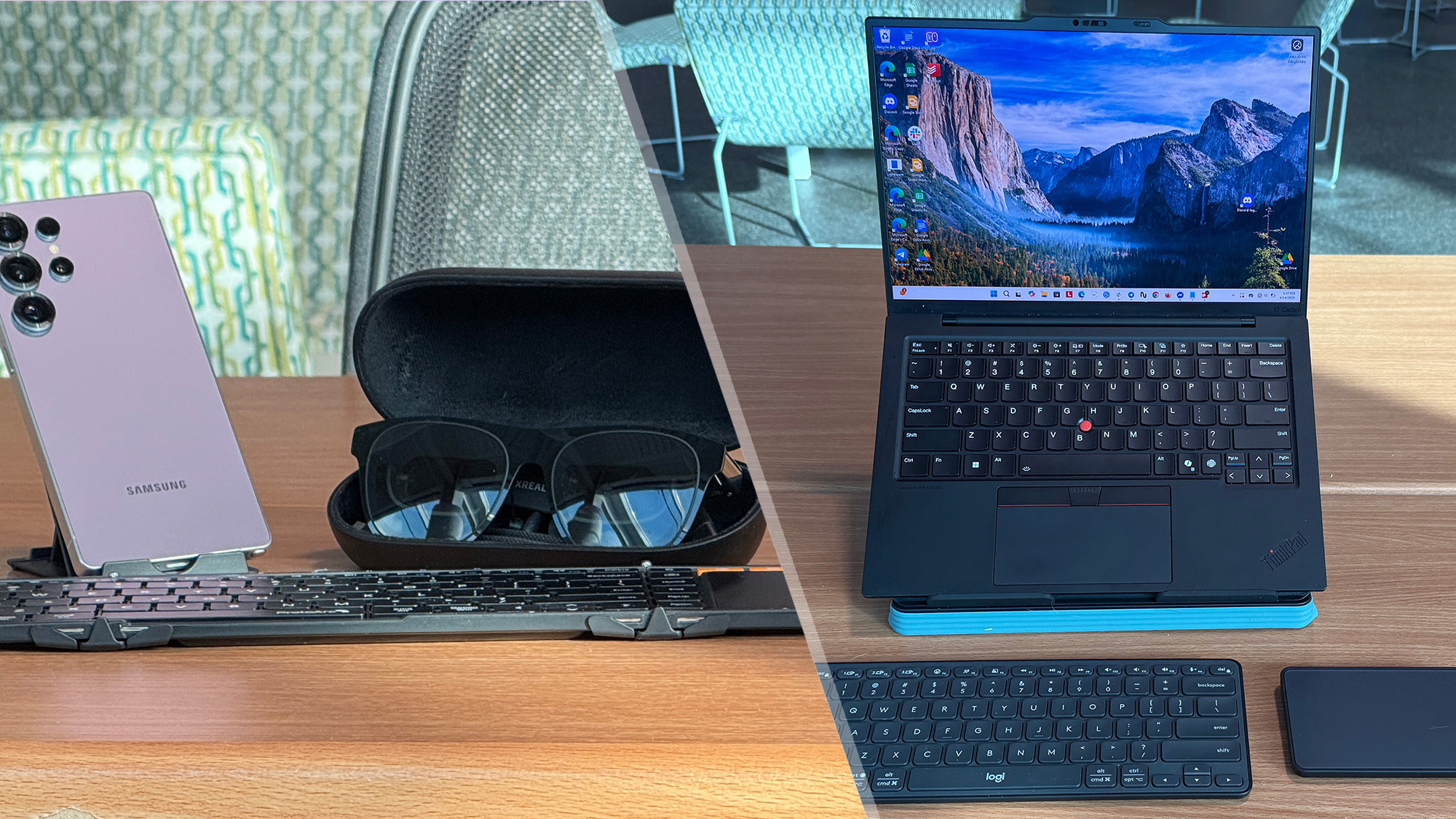Laptop Mag Verdict
The HTC One Max packs a ginormous 5.9-inch display, impressive sound quality and a fingerprint sensor, but it's a bulky device.
Pros
- +
Roomy, crisp display
- +
Best-in-class audio
- +
Long battery life
- +
Smooth performance
- +
Fingerprint scanner
Cons
- -
Cumbersome size
- -
Software not optimized for larger screen
- -
Camera blows out some images
- -
Expensive
Why you can trust Laptop Mag
Do you like the design of the HTC One but think its 4.7-inch screen just isn't big enough? Then the HTC One Max ($299 for Verizon Wireless) may be more your style. This phablet sports a roomier, 5.9-inch display while maintaining the aluminum design and BoomSound speakers we praised when reviewing its smaller brother. The Max also includes a fingerprint reader, making this device even more secure. But is this phablet really worth as much as the Galaxy Note?
Design
Calling the HTC One Max big is an understatement. The 5.9-inch smartphone feels more like a miniature tablet than it does a smartphone -- and it's heavier than your average phone, too.
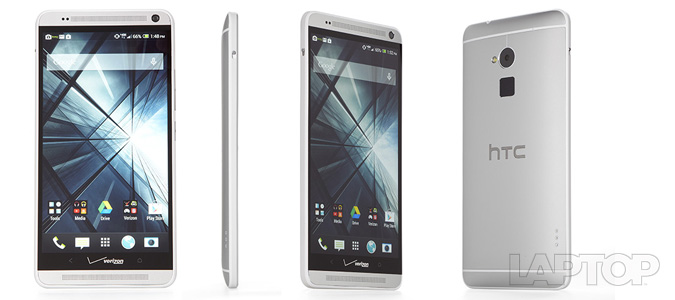
At 7.7 ounces, the One Max is heftier than the 7.26-ounce Nokia Lumia 1520, the 7-ounce 6.3-inch Samsung Galaxy Mega and the 5.9-ounce 5.7-inch Samsung Galaxy Note 3. That's largely because the Max sports an aluminum frame, while Samsung's devices have plastic backs. Measuring 6.5 x 3.2 x 0.41 inches, the HTC One Max is slightly thicker than but not as wide as the 6.5 x 3.5 x 0.3 Galaxy Mega. It's also noticeably longer, wider and thicker than the Galaxy Note 3.
MORE: Smartphone Buyers' Guide: 7 Things You Need to Know

Click to EnlargeIf you can tolerate the One Max's size, you'll appreciate that it has the same aluminum back and polycarbonate edging found on the One Mini. This makes the phablet look less premium than the standard-sized HTC One, but the Max's design is still attractive overall.
There is one feature of the One Max that you won't find on its smaller siblings. HTC placed a fingerprint scanner on the back of the device, just underneath the camera. The scanner itself is barely noticeable when you run your finger along the back of the phone. Still, we find the TouchID fingerprint reader built into the iPhone 5s' home button more convenient.
Display
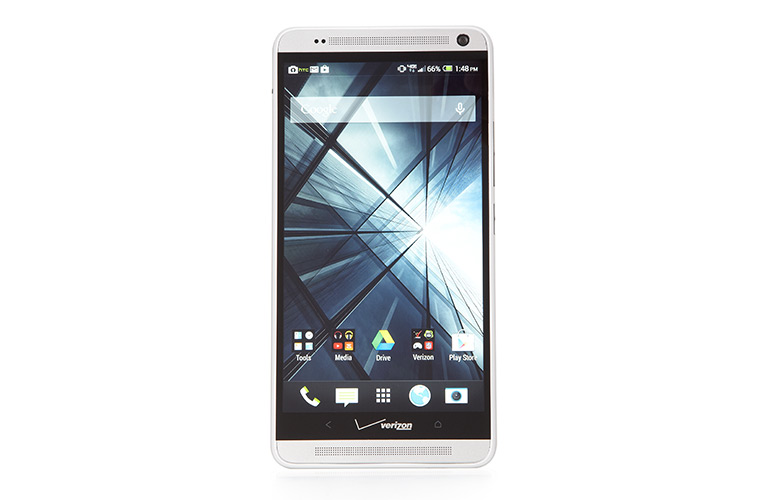
Click to EnlargeThe One Max's roomy, 5.9-inch, 1920 x 1080 display is just as sharp and vibrant as the 4.7-inch display on the regular-sized HTC One. When showing a trailer for "The Wolf of Wall Street," the One Max's display rendered crisper details than those of the Samsung Galaxy Mega (720p), Nokia Lumia 1520 (1080p) and Samsung Galaxy Note 3 (1080p).
However, the Note 3's 5.7-inch display was brighter and bolder than the One Max's screen. In a close up scene of Leonardo DiCaprio's face, we could see the subtle creases more easily on the Max than on the Note 3. While the Note 3 brought out the reds in DiCaprio's cheeks, the Max's colors looked more natural.
At 451 lux, the HTC One Max boasts one of the brightest phablet displays available. It outshone the smartphone category average (401 lux), the Nokia Lumia 1520 (328 lux) and the Samsung Galaxy Mega (427 lux). It trails the 555-lux Galaxy Note 3, though.
Audio
As is the case with the 4.7-inch HTC One, the One Max's front-facing dual BoomSound speakers deliver best-in-class audio. The monstrous handset pumped out cleaner and deeper tunes than its large-screened rivals by a long shot.
When listening to "Roar" by Katy Perry at full volume, we appreciated how well balanced the pop tune sounded through the One Max's speakers. The vocals and accompanying instrumentals sounded crisp and clear during the chorus. By comparison, the same song sounded tinny and bland coming out of the Note 3, Galaxy Mega and Nokia Lumia 1520.
The One Max blasted music at 83 decibels during the LAPTOP Audio Test, which is slightly louder than the 80-decibel smartphone category average, the Samsung Galaxy Note 3 (79 decibels) and the Galaxy Mega (82 decibels).
Keyboard
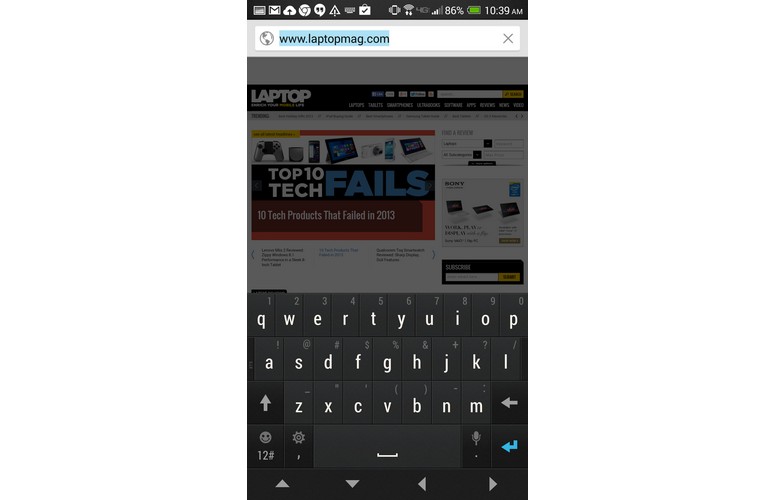
Click to EnlargeLike the other phones in its family, the One Max features the same HTC keyboard that offers trace-typing, autocorrect and next-word prediction. We found the keyboard to be smooth when we were typing text messages or keying in website URLs, but we only wish HTC included a one-handed mode like the Samsung Galaxy Mega. With the Mega, you can choose to use a virtual keyboard that floats toward one side of the screen.
Interface
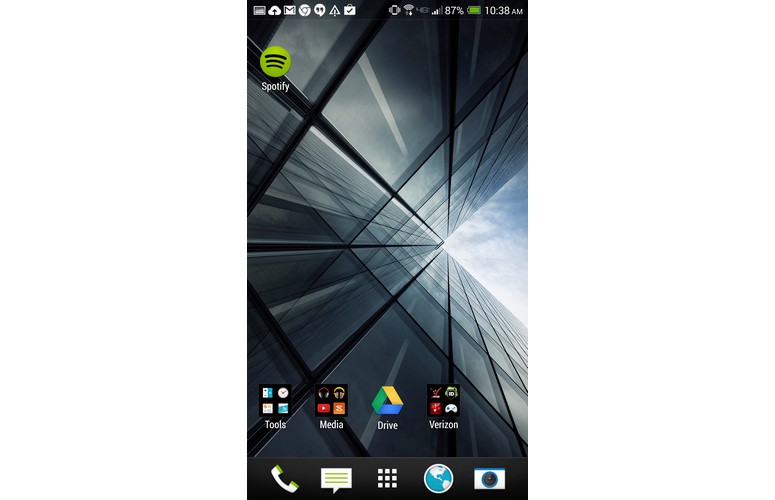
Click to EnlargeThe One Max runs a version of Android 4.3 skinned with HTC's Sense 5.5 software. Its most distinguishing feature is BlinkFeed, which displays a customizable mix of news and social media updates in the form of Windows Phone 8-like tiles. HTC offers a selection of publications to choose from, including The Huffington Post, Gawker, the AP and Reuters. Swiping in from the right side will pull up your list of topics, which you can add to by pressing the + icon at the top of the list.
If BlinkFeed isn't your style, you can opt to use it as a secondary home screen. Pressing and holding on any blank area of a home screen will pull up thumbnail views of all of them. From here, you can select which one you want to use as your primary home screen.
MORE: 12 Surprising Things Your Android Phone Can Do
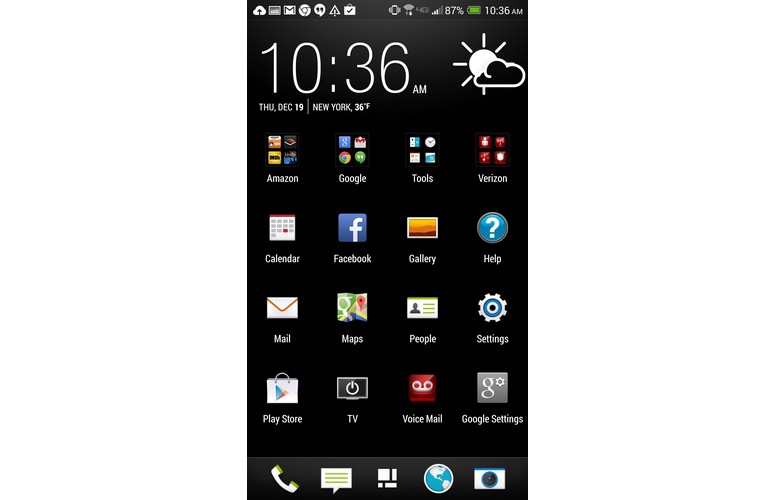
Click to EnlargeHTC Sense has a much cleaner and simpler feel than that of LG's Android skin or Samsung's TouchWiz overlay. The app drawer sports a plain black backdrop with no unnecessary animations or images. Users also have the option of changing the grid size from a 3 x 4 to a 4 x 5 layout.
Pulling down from the top of the display with two fingers reveals the One Max's quick-settings menu, which features shortcuts to settings such as display brightness, Bluetooth, Airplane Mode and Wi-Fi. HTC offers 12 options in this shortcut menu, while Samsung's TouchWiz UI includes 16.
Fingerprint Reader
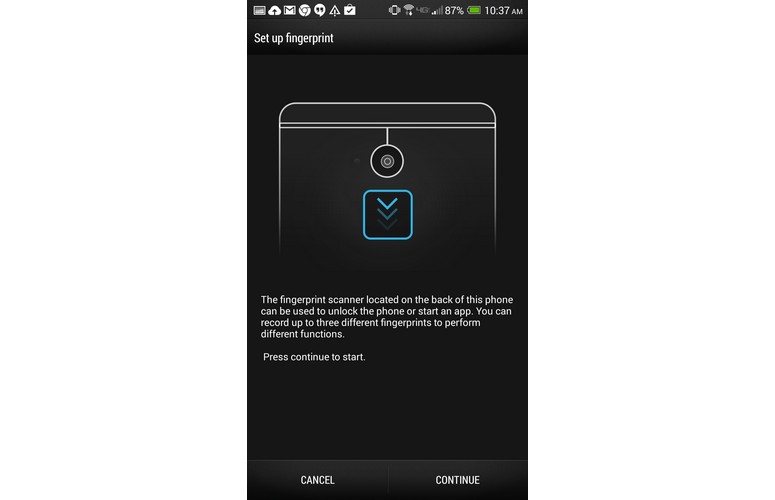
Click to EnlargeThe HTC One Max is one of the few smartphones with a built-in fingerprint reader. Using the biometric sensor, we unlocked the device and launched apps without having to type in a PIN or trace a pattern.
Setting up the scanner is simple. The HTC One Max's Settings menu houses a "Fingerprint Scan" option that lets you enroll and assign tasks to each finger. It takes four swipes for the device to successfully save a finger, and from there you can choose to just unlock the device, launch the camera or navigate to the Home screen, among other actions, by swiping your finger.
While you can do more with the One Max's fingerprint scanner than you can with the one on the iPhone 5s, which only lets you unlock the phone, we found its placement to be awkward. Those with smaller hands will have to stretch their fingers up the back of the phone to reach the sensor.
Performance
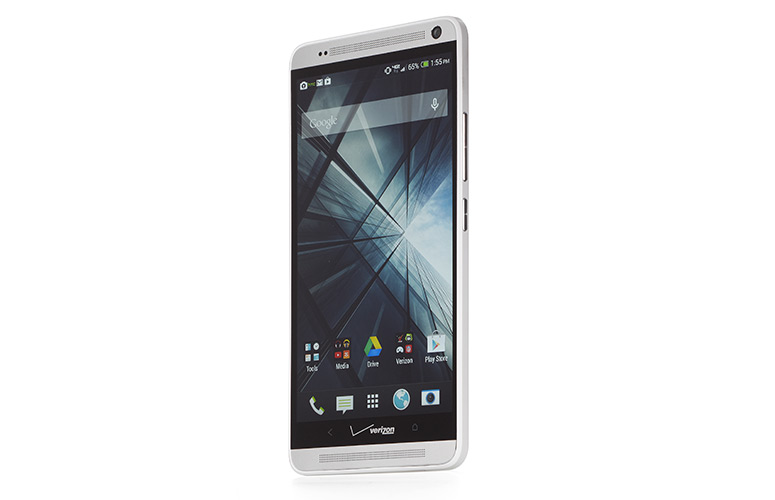
Click to EnlargeThe HTC One Max may be bigger than its siblings, but it comes with the same Qualcomm Snapdragon 600 processor with 2GB of RAM that the HTC One has. From launching apps to firing off the camera and multitasking, HTC's phablet offered brisk performance. When playing "N.O.V.A. 3" with six apps open -- including Chrome, the gallery app and Spotify -- the game ran without any hiccups. It only took 1.52 seconds to launch the camera with the same number of apps open, versus 1.39 seconds with no apps running.
The One Max also performed well on synthetic benchmark tests. During the Quadrant benchmark, which tests the CPU, I/O and graphics of a given device, the One Max scored 11,709, which is higher than the 7,884 smartphone category average. The Samsung Galaxy Mega, which runs on a 1.7-GHz dual Qualcomm MSM8930 Pro processor, scored a lower 8,203, while the Snapdragon 800-powered Galaxy Note 3 scored the highest at 22,279.
On Geekbench 3, the One Max's score of 1,867 outperformed the smartphone category average (1,634) and the Galaxy Mega (1,098), but the Note 3 again came out on top (2,883).
It took the One Max 7 minutes and 44 seconds to transcode a 204MB video from 1080p to 480p using Vidtrim. That's faster than the category average (8:15) and the Mega (9:15). Once again, though, the Note 3 proved faster, finishing in 5:15.
The Max scored 10,938 on the 3DMark Unlimited graphics test, which measures mobile chipset graphics and physics performance using OpenGL ES 2.0. This is higher than the 9,940 smartphone category average and the Galaxy Mega's score of 4,552, but the Note 3 scored a monstrous 18,808.
Camera and Camcorder

Click to EnlargeThe One Max's Ultrapixel f/2.0 aperture lens captures clear and vibrant images in daylight. A close-up image of pine needles on a shrub was more detailed than the same photo taken with the Galaxy Mega's 8-MP camera and the Note 3's 13-MP shooter, although images taken with Samsung's phones boasted bolder colors.
The Lumia 1520's 20-megapixel camera remains unmatched, however. Not only did the Windows Phone phablet produce richer greens, but the subject also looked noticeably sharper than in the rest of the bunch.
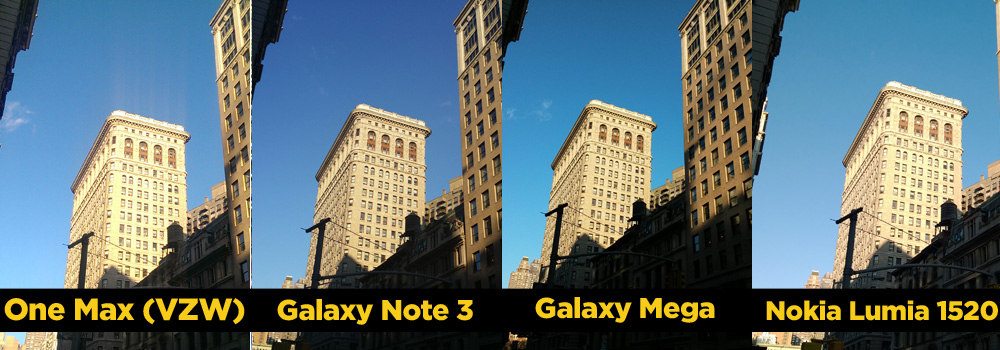
Click to EnlargeAlthough the One Max takes high-quality photos, we did notice that some images looked too bright. In a photo taken of the Flatiron Building's back, the One Max's image made the top of the building look blown out compared to other what other phablets captured.
The One Max's 1080p camcorder captured clear and colorful footage of a busy New York City street. However, the footage suffers from the same issue as the camera and renders sunlit areas too bright.
[sc:video id="VwbnE1cTpj-thUkaLqhXeCYZhKgbqurT" width="575" height="398"]
The One Max's front-facing, 2.1-MP camera produced decent images, but white shades looked way too bright. While the red colors in our hair and the pink and green bits of our skirt looked accurate, the wall behind us looked extremely blown out.
Apps

Click to EnlargeLike most Verizon handsets, the HTC One Max comes with an entire folder of Verizon's apps. These include My Verizon Mobile, which helps you keep track of your data usage for the month and manage your plan, and VZ Mobile Security, which protects your phone from malware and blocks potentially dangerous websites. The NFL Mobile app lets you choose the teams you most frequently follow and aggregates news based on your choices.
MORE: 25 Best Android Apps
In addition to Google's suite of first-party apps, the One Max also comes preloaded with Amazon, Slacker, Audible and IMDb.
LTE and Web Browsing
Verizon boasts the largest LTE network in the United States, with nearly 500 markets, but that doesn't mean its service is always the fastest. We saw mixed results during our testing, with data speeds varying wildly.
Download speeds averaged an exceptional 57.6 Mbps when we used the Speedtest.net app in Old Bridge, N.J. Upload speeds averaged 16.1 Mbps in the same location. However, in our New York City office, the HTC One Max averaged a terrible 350 Kbps for downloads and a worse 100 Kbps for uploads.
We also experienced inconsistent Web surfing speeds in our office over LTE. During our first try, we could barely load websites using Chrome on the One Max. Laptopmag.com took an average of 18.27 seconds, while both The New York Times and ESPN.com failed to load for 25 seconds. The next time we tried visiting these websites, however, they popped up more quickly. Laptopmag.com loaded in 9.3 seconds, while ESPN took 3.4 seconds and NYTimes.com 2.8 seconds.
Battery Life
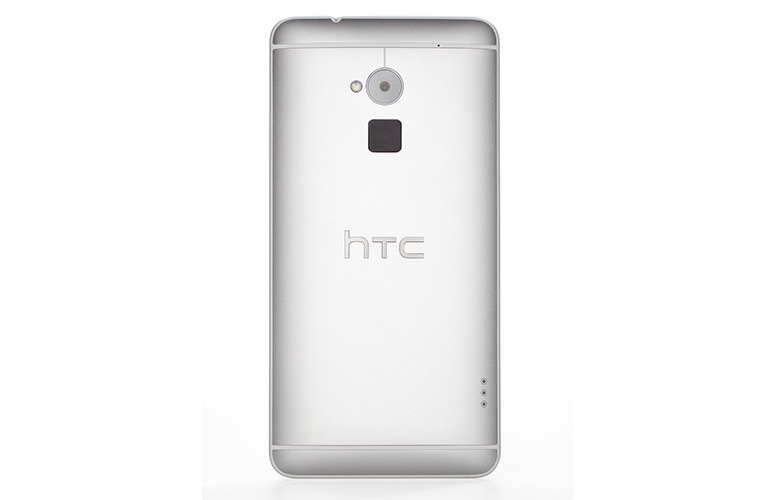
Click to EnlargeThe HTC One Max lasts much longer than your average smartphone, and it should because it packs a high-capacity, 3,300 mAh battery. HTC's phablet survived for 8 hours and 52 minutes on the LAPTOP Battery Test, which consists of continuous Web surfing over 4G LTE with the display brightness set to 40 percent. This is longer than the average smartphone (6:41) and the Samsung Galaxy Mega (7:03), but the Samsung Galaxy Note 3 (9:57) and the Nokia Lumia 1520 (11:28 on AT&T) lasted even longer.
MORE: 10 Smartphones with the Longest Battery Life
Verdict

Click to EnlargeThe HTC One Max is a case of too much of a good thing. It comes with everything we loved in the original One, including best-in-class audio, a dynamic BlinkFeed interface and an appealing aluminum design. However, while having such a large screen is great, the software isn't optimized for a screen that size, and the design will be too bulky for many users. The rear-mounted fingerprint scanner can also be tough to reach.
The $299 Samsung Galaxy Note 3 makes better use of its display's roomy real estate by providing an S Pen stylus and split-screen multitasking. Plus, it boasts longer battery life and a faster CPU in a lighter design. Ultimately, the One Max is worth a look for those who want a supersized One, but HTC will need to do more to win shoppers away from Samsung.
- Game Changer Awards - The Most Innovative Tech of 2013
- Top 10 iPhone Alternatives
- Best Bluetooth Speakers 2014
HTC One Max (Verizon) Specs
| Alternate Carriers | Unlocked, Sprint |
| Audio formats supported | OGG, AAC+, MP3, AAC, MIDI, FLAC, AMR-NB, WMA, AMR WB, WAV, AMR |
| Bluetooth Type | Bluetooth 4.0 |
| Brand | HTC |
| CPU | 1.7-GHz quad-core Qualcomm Snapdragon 600 processor |
| Camera Resolution | 4 MP |
| Carrier | Verizon |
| Company Website | www.htc.com |
| Data | CDMA, UMTS, HSPA, GSM, GPRS/EDGE, EV-DO Rev. A, EDGE |
| Display (main) | 5.9-inch 1920 x 1080 Super LCD 3 |
| Display Resolution | 1920x1080 |
| Form Factor | Candybar Touchscreen |
| Front Camera Resolution | 2.1MP |
| GPS | Yes |
| Internal Memory | 32GB |
| Memory Expansion Type | miniSD Card |
| Networks | Verizon LTE: 800/1900 MHz, EDGE/GPRS/GSM: 850/900/1800/1900 MHz, HSPA/UMTS: (850/900/1900/2100 MHz) |
| OS Family | Android |
| Operating System | Android 4.3 |
| Phone Display Size | 5.9 |
| Ports | microUSB, microSD, 3.5mm headphone |
| Processor Family | Qualcomm Snapdragon 600 |
| RAM | 2GB |
| Size | 6.5 x 3.2 x 0.41 inches |
| Video formats supported | WMV, MPEG-4, H.264, H.263 |
| Weight | 7.7 ounces |
| Wi-Fi | 802.11 a/b/g/n/ac |

